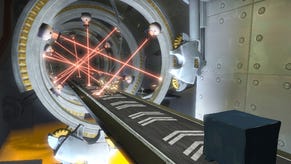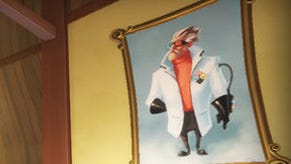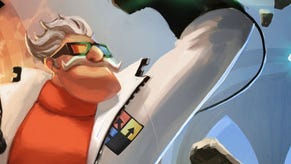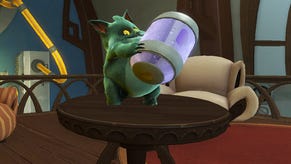Quantum Conundrum
Oh boy.
The pressure's got to be high for Portal lead designer Kim Swift. After creating one of the most influential games of the generation, Swift decided to leave the company that put Gordon Freeman on the map and pursue her own venture at indie studio Airtight Games.
Quantum Conundrum, Swift's first title since GLaDOS' debut, may not be a million miles away from Portal with its focus on first person physics-based puzzling. But it contains the unique brainteasers and adorable humor that made her last game such a rousing success (what? You thought I was going to call it a triumph?).
You play as a boy sent to stay at your uncle's manor for the weekend while your parents get some R & R. Given your uncle's shock of grey hair, white lab coat, and moniker - the delightfully improbable Professor Quadwrangle - it should come as no surprise that he's a mad scientist.
While this concept is ripe with Southern gothic connotations, Quantum Conundrum takes this in a friendlier direction. He's ostensibly more of a Nutty Professor than a Dr. Frankenstein, and as it turns out, he was working on a device to travel between different dimensions until he got stuck in another one, leaving you to find him.
Shortly after arriving you discover his Inter-Dimensional Shift device (IDS device). This allows you to dynamically travel between alternate dimensions that maintain the same physical properties as your current environment, but that influence things like time and gravity.
In order to swap between dimensions, you must find an IDS battery that acts as a wi-fi hotspot for inter-dimensionality, and then place it in a terminal giving you access to that realm at the touch of a button.

Thanks to your uncle's scientific obsessions, the manor house has been retrofitted with various chambers to test his hypotheses. This essentially turns it into a bunch of puzzle rooms not unlike Swift's most well known work (though unlike Portal the visual style of is bright and colourful, giving it a gentle cartoon-like quality befitting of its family friendly subject matter).
To ensure you're always prepared for what may come, each puzzle is equipped with a Dynamic Object Linear Ligation Interface, or DOLLI for short. She's a cloning device portrayed as a silent metal face with a big shiny tongue that's used to make sure his experiments run properly. Helpfully, she'll always give you the necessary components for the job, should you drop a vital object into a pool of acid for example.
The first dimension thrown up is the fluffy one. Here, everything is covered in a layer of white fur and weighs very little. Heavy objects like safes can be moved so you can jump on top of them, or they can be placed on weight sensitive plates. Need to break a glass wall? Pick up a safe in the fluffy dimension, throw it and then quickly switch back to the original dimension so its weight will smash through the wall.
Next up is the self-explanatory anti-gravity dimension. Here we learn the basics of using safes as elevators by reversing their gravity so we can ride them up or use them to hit switches on the ceiling. Another dimension slows down the action by a factor of 20, bathing everything in sepia to underline the effect.









.png?width=291&height=164&fit=crop&quality=80&format=jpg&auto=webp)




.jpg?width=291&height=164&fit=crop&quality=80&format=jpg&auto=webp)
